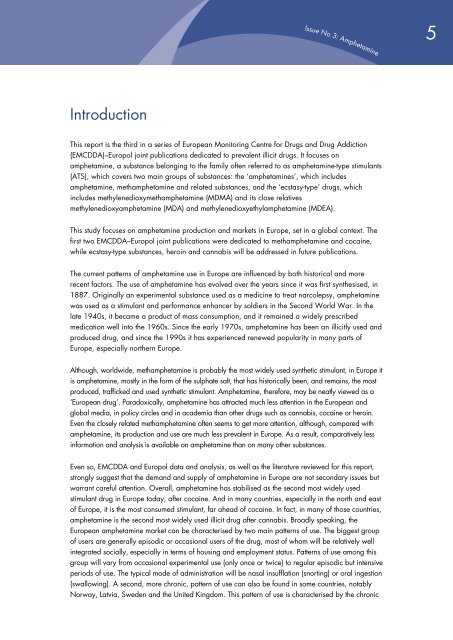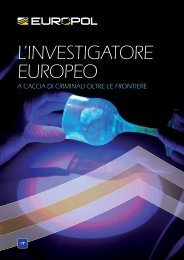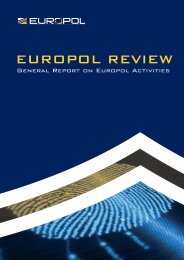EMCDDA–Europol joint publications Amphetamine - Europol - Europa
EMCDDA–Europol joint publications Amphetamine - Europol - Europa
EMCDDA–Europol joint publications Amphetamine - Europol - Europa
You also want an ePaper? Increase the reach of your titles
YUMPU automatically turns print PDFs into web optimized ePapers that Google loves.
Introduction<br />
Issue No 3: <strong>Amphetamine</strong><br />
This report is the third in a series of European Monitoring Centre for Drugs and Drug Addiction<br />
(EMCDDA)–<strong>Europol</strong> <strong>joint</strong> <strong>publications</strong> dedicated to prevalent illicit drugs. It focuses on<br />
amphetamine, a substance belonging to the family often referred to as amphetamine-type stimulants<br />
(ATS), which covers two main groups of substances: the ‘amphetamines’, which includes<br />
amphetamine, methamphetamine and related substances, and the ‘ecstasy-type’ drugs, which<br />
includes methylenedioxymethamphetamine (MDMA) and its close relatives<br />
methylenedioxyamphetamine (MDA) and methylenedioxyethylamphetamine (MDEA).<br />
This study focuses on amphetamine production and markets in Europe, set in a global context. The<br />
first two <strong>EMCDDA–<strong>Europol</strong></strong> <strong>joint</strong> <strong>publications</strong> were dedicated to methamphetamine and cocaine,<br />
while ecstasy-type substances, heroin and cannabis will be addressed in future <strong>publications</strong>.<br />
The current patterns of amphetamine use in Europe are influenced by both historical and more<br />
recent factors. The use of amphetamine has evolved over the years since it was first synthesised, in<br />
1887. Originally an experimental substance used as a medicine to treat narcolepsy, amphetamine<br />
was used as a stimulant and performance enhancer by soldiers in the Second World War. In the<br />
late 1940s, it became a product of mass consumption, and it remained a widely prescribed<br />
medication well into the 1960s. Since the early 1970s, amphetamine has been an illicitly used and<br />
produced drug, and since the 1990s it has experienced renewed popularity in many parts of<br />
Europe, especially northern Europe.<br />
Although, worldwide, methamphetamine is probably the most widely used synthetic stimulant, in Europe it<br />
is amphetamine, mostly in the form of the sulphate salt, that has historically been, and remains, the most<br />
produced, trafficked and used synthetic stimulant. <strong>Amphetamine</strong>, therefore, may be neatly viewed as a<br />
‘European drug’. Paradoxically, amphetamine has attracted much less attention in the European and<br />
global media, in policy circles and in academia than other drugs such as cannabis, cocaine or heroin.<br />
Even the closely related methamphetamine often seems to get more attention, although, compared with<br />
amphetamine, its production and use are much less prevalent in Europe. As a result, comparatively less<br />
information and analysis is available on amphetamine than on many other substances.<br />
Even so, EMCDDA and <strong>Europol</strong> data and analysis, as well as the literature reviewed for this report,<br />
strongly suggest that the demand and supply of amphetamine in Europe are not secondary issues but<br />
warrant careful attention. Overall, amphetamine has stabilised as the second most widely used<br />
stimulant drug in Europe today, after cocaine. And in many countries, especially in the north and east<br />
of Europe, it is the most consumed stimulant, far ahead of cocaine. In fact, in many of those countries,<br />
amphetamine is the second most widely used illicit drug after cannabis. Broadly speaking, the<br />
European amphetamine market can be characterised by two main patterns of use. The biggest group<br />
of users are generally episodic or occasional users of the drug, most of whom will be relatively well<br />
integrated socially, especially in terms of housing and employment status. Patterns of use among this<br />
group will vary from occasional experimental use (only once or twice) to regular episodic but intensive<br />
periods of use. The typical mode of administration will be nasal insufflation (snorting) or oral ingestion<br />
(swallowing). A second, more chronic, pattern of use can also be found in some countries, notably<br />
Norway, Latvia, Sweden and the United Kingdom. This pattern of use is characterised by the chronic<br />
5







